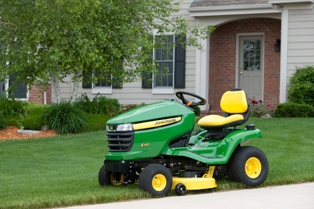When it comes to grass – whether it’s in the paddock or around the house – there always seems to be too little or too much. With so many jobs to do around the farm, lawn mowing is often left until last.
A ride-on mower is one piece of farm machinery that can make the job of lawn mowing a faster, easier and safer task.
Ride-on mower or lawn tractor?
Any lawn mower that you sit on can be called a ride on. However, the term lawn tractor usually refers to a mower where the engine is mounted on the front and the cutting deck is underneath.
Ride-on mowers with the cutting deck out the front are called zero-turn mowers because they can turn sharply and have increased manoeuvrability. Zero-turn ride-on mowers are controlled by levers and foot pedals, whereas the lawn tractor is controlled by a steering wheel and pedals.
Before purchasing a ride-on mower, you should consider the amount of work and use it will have around the house and/or out in the paddock, and the type of grass (established lawn) that it will be cutting.
 |
Cutting deck
If you only consider one thing prior to purchase, make it the features of the cutting deck. The size of the cutting deck will depend on the area of lawn to be mowed and the terrain. For example, a smaller deck is better suited to uneven slopes as it is less likely to dig in. Cutting decks come in single or twin configurations, depending on the cutting width.
Check the number of blades under each deck, which will vary between 2 and 4. Four blades will be able to cope with heavier grass and will provide a more even finish.
Research whether the blades swing back or if they bolt on. Blades that can swing back when they hit an obstacle like a rock or stump help protect the cutting assembly and increase mower longevity.
Consider the minimum and maximum cutting height. For a showpiece lawn, a cutting height as low as 10-20mm will be required, whilst paddock work will require a cutting height of 15cm or more.
Discharge, mulch or catch?
Consider if the ride-on mower will be required to discharge the grass to the side or rear, and if it will be required to mulch or catch the grass. A mower with a catcher requires more horsepower as a draft is required to ‘push’ the grass into the catcher. Some mowers have a flexible catcher option where it can be added and removed as required. Check to see if the catcher has a manual, tipping or hydraulic system for emptying.
If you live in a high rainfall area and are likely to mow wet grass, be aware that catchers used in these conditions can easily block up. As an alternative, consider a mower with a mulching option, which enables grass to be finely chopped and spread evenly across the lawn.
Horsepower
The larger the cutting deck, the greater the horsepower requirement and initial expense. Ride-on mowers usually range from 9 to 27 horsepower. A larger horsepower does not necessarily mean a better mower.
The amount of horsepower required depends on the size of the cutting deck, the terrain to be mown and whether a catcher is required. Larger horsepower mowers use more fuel and have higher running costs.
Additional uses
Ride-on mowers can do more than just cut and catch grass. Some come with a tow bar and are capable of towing a small trailer. Although a ride-on mower is not designed to replace a tractor, it can however be a useful farm machinery addition around a small farm.
Safety, maintenance and warranty
A ride-on lawn mower is potentially a dangerous piece of farm machinery, so safety is an important consideration. Ensure that the mower is fitted with the appropriate guards and it has an automatic safety switch which cuts the motor off once weight is removed from the seat.
The cost of the mower does not stop at its purchase. Investigate its fuel consumption and cost of servicing and spare parts. Also, compare the warranty period between brands and understand the terms and conditions as some mowers need to be serviced by a qualified technician.
Where to from here?
Talk to friends and neighbours about the pros and cons of different lawn mower brands. When shopping around, have a list of questions to ask each salesperson and find out if they do demonstrations so you can test ride the mower.
 |
The author Charlie Roberts is one of the FarmStyle Australia experts, he has a Bachelor of Farm Management and a Masters of Business Administration. He has worked for a number of agricultural companies in both New Zealand and Australia. He has a wealth of experience working with farmers in a range of environments. |



